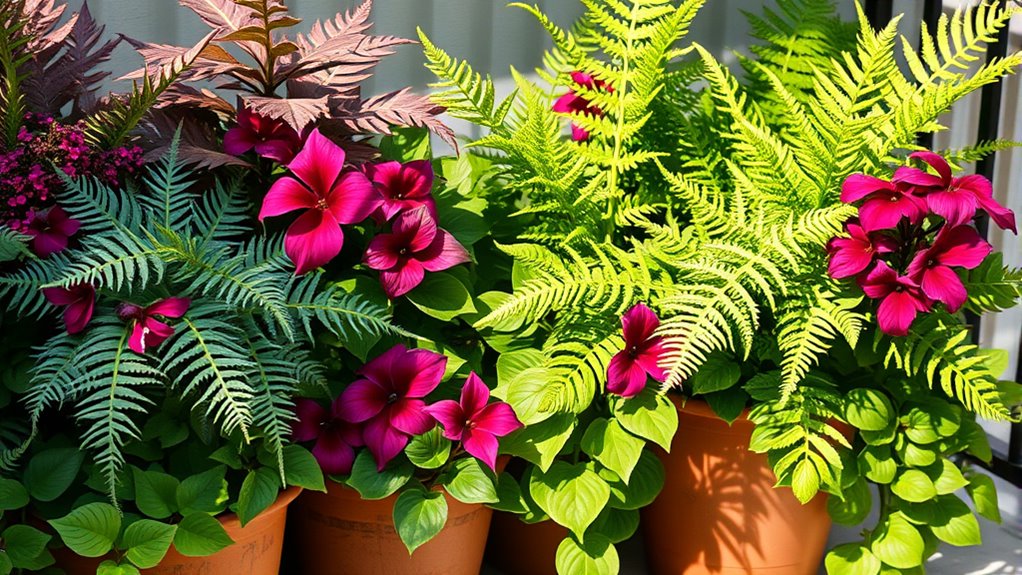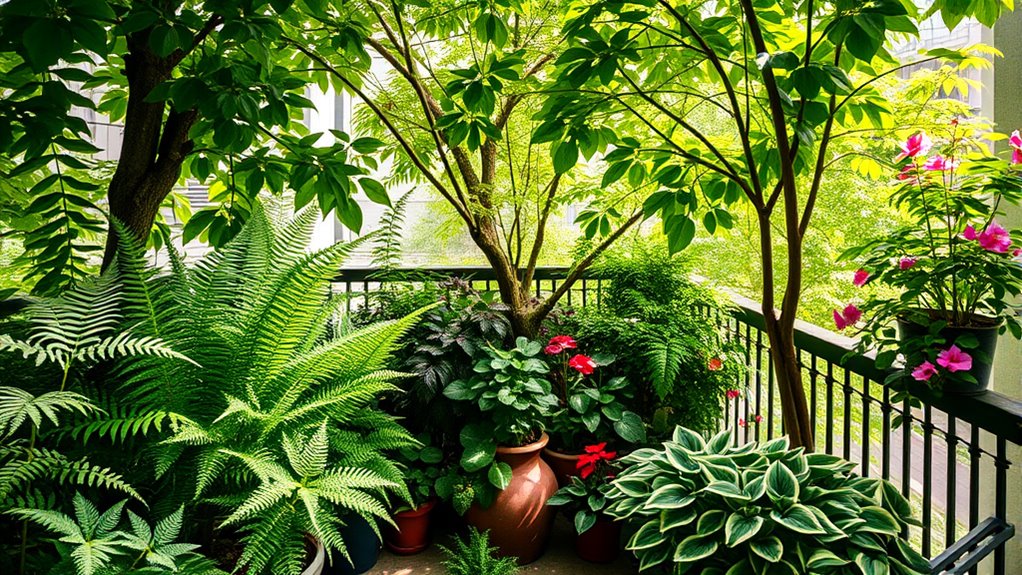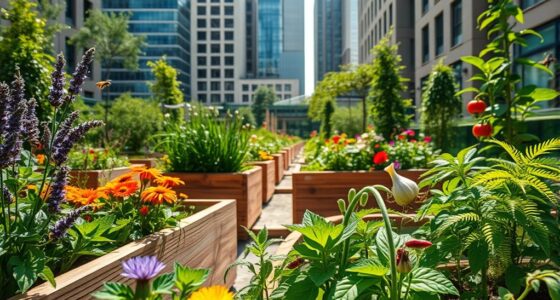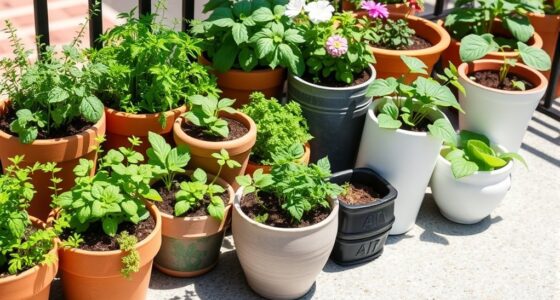To create a thriving low-sun balcony garden, choose shade-loving plants like ferns, hostas, impatiens, and begonias that thrive in limited light. Use containers of various sizes and heights to add visual interest and make the most of your space. Proper watering, well-draining soil, and strategic placement guarantee healthy plants. With these tips, you’ll transform your balcony into a green oasis—keep exploring to discover more ideas for your shaded garden.
Key Takeaways
- Choose shade-tolerant plants like ferns, hostas, impatiens, and begonias that thrive with low sunlight.
- Use containers of varying sizes and colors to maximize space and add visual interest.
- Ensure proper drainage and well-draining soil to prevent root rot in shaded, moisture-retentive areas.
- Incorporate vertical elements such as hanging baskets or climbing plants to utilize limited balcony space.
- Add soft lighting and decorative accents to enhance the garden’s ambiance during cloudy days and evenings.

Have you ever wondered how to create a lush garden in shady spots? If your balcony or outdoor space gets limited sunlight, don’t worry—you can still craft a vibrant green oasis. The key is choosing the right plants and understanding how to care for them. When considering indoor plant care for a shaded balcony, think about plants that thrive in low-light conditions. Many of these plants are surprisingly easy to maintain and can turn even the dullest corner into a thriving garden. Incorporate garden design ideas that maximize the space and light you do have, such as placing taller plants at the back and layering smaller ones in front. Use containers of varying heights and colors to add visual interest and depth, making your balcony feel more inviting.
Create a lush, low-light garden with smart plant choices and thoughtful container arrangements.
For shade gardens, selecting plants that naturally flourish in low-light conditions is essential. Ferns are a classic choice—they add lush foliage and require minimal maintenance. Hostas are another excellent option, providing large, attractive leaves that brighten shaded areas. If you want some flowering plants, consider impatiens or begonias, which bloom beautifully in low light and bring color to your space. These plants tend to be forgiving regarding indoor plant care, making them perfect for beginners or busy garden enthusiasts. To keep everything thriving, ensure your plants are not overwatered; shaded areas tend to retain moisture longer, so check the soil regularly before watering. Additionally, use well-draining soil to prevent root rot.
Incorporating these plants into your garden design ideas is simple. Use hanging baskets for trailing plants like creeping fig or ivy to add vertical interest. Place shade-loving shrubs or small trees in larger pots to create a sense of enclosure and privacy. Think about adding decorative stones or mulch around your plants to help retain moisture and reduce weeds. Lighting can also play a role—adding soft outdoor lights can highlight your plants and make your garden inviting even during cloudy days or evenings. Remember, a successful shade garden isn’t just about the plants you select but also about creating a harmonious environment that balances light, color, and texture.
With the right approach to indoor plant care and thoughtful garden design ideas, your low-sun balcony can become a lush, welcoming retreat. Focus on choosing plants that love shade, and don’t be afraid to experiment with container arrangements and decorative accents. Even in the absence of direct sunlight, you can cultivate a thriving green space that brings tranquility and beauty to your everyday life.
Frequently Asked Questions
Can I Grow Vegetables in Shaded Balcony Gardens?
Yes, you can grow vegetables in a shaded balcony garden. Focus on shade tolerant vegetables like leafy greens, lettuce, spinach, and arugula. Additionally, low light edible herbs such as mint, parsley, and chives thrive in limited sunlight. Use containers with good drainage, and guarantee you provide some indirect light whenever possible. With the right choices, your shaded balcony can yield fresh, homegrown vegetables and herbs effectively.
How Often Should I Water Shade-Loving Balcony Plants?
Watering your shade-loving balcony plants isn’t a task you want to take lightly—they can be more delicate than a soap bubble! You should check soil moisture regularly and water when the top inch feels dry. Typically, watering frequency depends on factors like weather and pot size, but aim for consistent moisture without overdoing it. Monitoring soil moisture helps you keep your plants healthy and thriving, even in low sun spots.
Are There Any Specific Fertilizers for Low Sun Plants?
You wonder if there are specific fertilizers for low sun plants. For these plants, you should choose fertilizer types that meet their nutrient requirements without overdoing it. Look for a balanced, slow-release fertilizer or one with a lower nitrogen content to avoid over-stimulating growth. Always follow label instructions, and consider using a liquid fertilizer periodically to provide essential nutrients, ensuring your shade-loving plants thrive even in low sunlight conditions.
How Do I Prevent Pests on Shaded Balcony Plants?
To prevent pests on your shaded balcony plants, focus on pest prevention strategies like keeping your plants healthy and monitoring regularly. Use natural repellents such as neem oil or insecticidal soap to ward off unwanted visitors without chemicals. Remove any debris or fallen leaves promptly, and encourage beneficial insects like ladybugs or lacewings. These steps help safeguard your plants naturally, ensuring your balcony remains lush and pest-free.
What Are the Best Containers for Shade Garden Plants?
You might think all containers work for shade garden plants, but the truth is, your container choices impact plant health. Opt for materials like terracotta or plastic, which provide good drainage and insulation. Consider lightweight options for easy handling and guarantee your containers have drainage holes. By choosing the right materials and size, you create an ideal environment that keeps your shady balcony plants thriving, even in low sun conditions.
Conclusion
Even in the shadowed corners of your balcony, life blooms vibrantly, defying the gloom with bursts of color and lush greenery. While the sun’s warmth may hide behind clouds, your plants thrive in the cool, gentle shade, turning quiet corners into lively, inviting spaces. Embrace the subtle beauty of low sun gardening, where resilience meets serenity. With patience and care, your shaded balcony transforms into a lush retreat, proof that even darkness can nurture stunning life.









